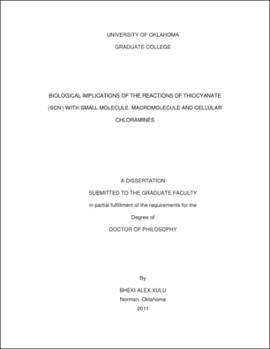| dc.contributor.advisor | Ashby, Michael T | |
| dc.creator | Xulu, Bheki Alex | |
| dc.date.accessioned | 2019-04-27T21:26:11Z | |
| dc.date.available | 2019-04-27T21:26:11Z | |
| dc.date.issued | 2011 | |
| dc.identifier | 99192278702042 | |
| dc.identifier.uri | https://hdl.handle.net/11244/318676 | |
| dc.description.abstract | Hypochlorous acid (HOCl) is one of the major neutrophil-derived oxidants used to kill invading pathogens. However, excess or misplaced production of HOCl can damage host tissue as it reacts indiscriminately with biological molecules such as amino acids. Chloramines are a major product of the reaction between HOCl and amino acids. As they decompose, protein-bound chloramines can permanently damage proteins by altering their structures and function. Thiocyanate (SCN-) reacts efficiently with HOCl and thus is able to limit its propensity to inflict host tissue damage. The concentration of SCN- in human physiologic fluids varies depending on the source of fluid and the individuals dietary and smoking habits. For example, normal human blood plasma has micromolar levels of SCN- while the oral cavity has millimolar concentrations. | |
| dc.description.abstract | The first chapter of this dissertation covers the objectives of the research and the introduction of the important themes. The second chapter summarizes the experimental methods and the analytical techniques used to conduct the research. The third chapter of this dissertation is focused on the reaction of SCN- with chloramines. We found that SCN- reacts efficiently with chloramines in small molecules, in proteins, and in Escherichia coli cells to give OSCN- and the parent amine. We also observed that chloramines react faster with OSCN- than SCN-. This suggests that the reductions of chloramines by SCN- and OSCN- have potential biological significance as they may repair some of the damage infected by HOCl on proteins. | |
| dc.description.abstract | Under slightly acidic pH conditions, chloramines disproportionate to dichloramines. In the fourth chapter, the reactivity of dichloramines towards thiols was examined. We found that at equimolar concentrations, the dichloramines react much faster with thiols than monochloramines. Chlorotaurine reacts with thiols with a (pH-dependent) pseudo-second order rate constant of 102 M-1s-1 while the rate constant for dichlorotaurine is 106 M-1s-1 at pH 7.4. These results suggest that the more stable dichloramines (e.g. those on lysine residues and on taurine) may be playing a role, at least in part, in the killing of phagocytosed bacteria. | |
| dc.description.abstract | The fifth chapter of this dissertation evaluates the biological significance of the reaction of SCN- with chloramines. To achieve this goal, we investigated the extent to which SCN- restored the activity of glutathione reductase (GR) and also how it affected the population of viable A549 lung cancer cells after treatment with HOCl. Under certain conditions, we found that approximately half of GR activity that was inactivated by a large molar excess of HOCl was recovered after incubation with SCN-. We speculate that the cysteine active site of the protein was protected from irreversible over-oxidation by its hydrophobicity. The observed reversibility upon reaction with thiocyanate is attributed to a chlorinated key histidine. The viability studies of A549 cells incubated with HOCl for 20 min and then with SCN- show a significant increase in the proportion of live cells and a decrease in the proportion of necrotic cells. We surmise based on these results that early SCN- intervention (20 min) after the exposure of A549 cells to low concentrations of HOCl can repair and reverse some of the damage. Overall, the results of the investigation described in this dissertation indicate that SCN- may play a more active role in quenching chloramines in vivo than has been previously appreciated. | |
| dc.format.extent | 165 pages | |
| dc.format.medium | application.pdf | |
| dc.language | en_US | |
| dc.relation.requires | Adobe Acrobat Reader | |
| dc.subject | Thiocyanates | |
| dc.subject | Chloramines | |
| dc.subject | Neutrophils | |
| dc.subject | Hypochlorites | |
| dc.title | BIOLOGICAL IMPLICATIONS OF THE REACTIONS OF THIOCYANATE (SCN | |
| dc.type | text | |
| dc.type | document | |
| dc.thesis.degree | Ph.D. | |
| ou.group | College of Arts and Sciences::Department of Chemistry and Biochemistry | |
